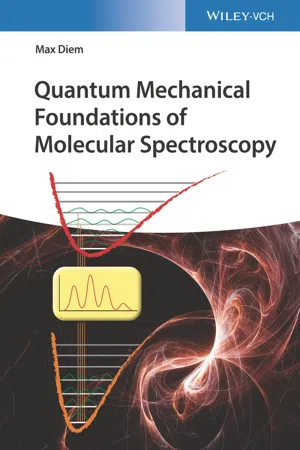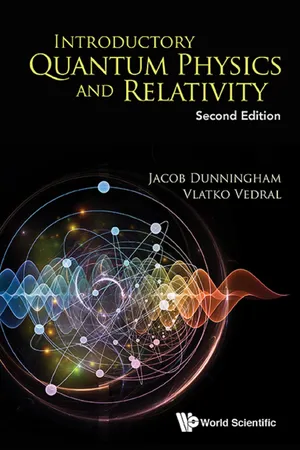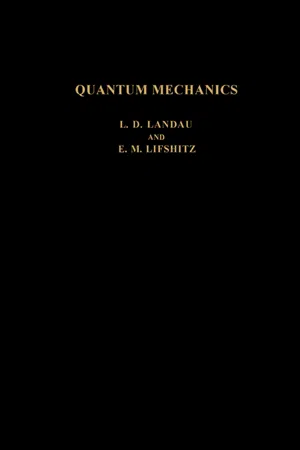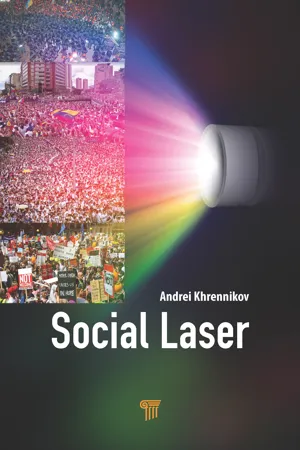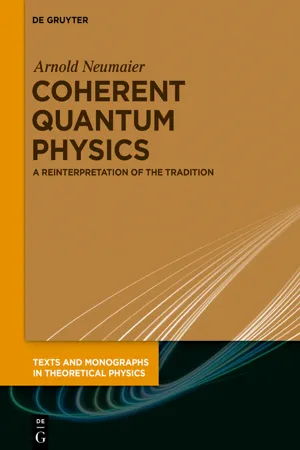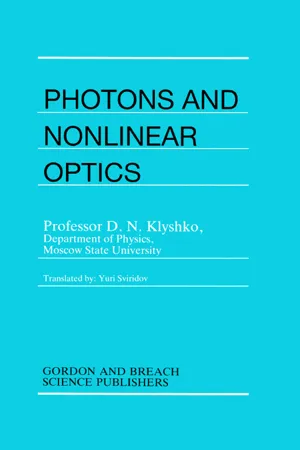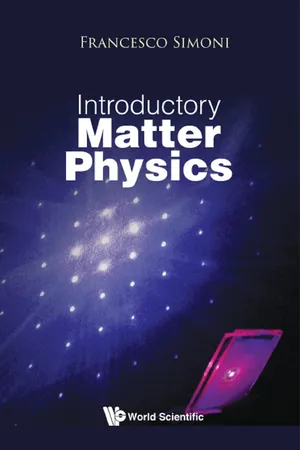Physics
Postulates of Quantum Mechanics
The postulates of quantum mechanics are fundamental principles that describe the behavior of quantum systems. They include concepts such as wave-particle duality, superposition, and the uncertainty principle. These postulates form the foundation of quantum mechanics and are used to make predictions about the behavior of particles at the atomic and subatomic levels.
Written by Perlego with AI-assistance
Related key terms
Related key terms
1 of 4
Related key terms
1 of 3
10 Key excerpts on "Postulates of Quantum Mechanics"
- Max Diem(Author)
- 2021(Publication Date)
- Wiley-VCH(Publisher)
Since the position and momentum can never be determined simultaneously at any point in time, the position (or momentum) in the future cannot be precisely predicted, only the probability of either of them. This is manifested in the postulate that all properties, present or future, of a particle are contained in a quantity known as the wavefunction Ψ of a system. This function, in general, depends on spatial coordinates and time; thus, for a one‐dimensional motion (to be discussed first), the wavefunction is written as Ψ(x, t). The probability of finding a quantum mechanical system at any time is given by the integral of the square of this wavefunction: ∫Ψ(x, t) 2 d x. This is, in fact, one of the “postulates” on which quantum mechanics is based to be discussed next. Different authors list these postulates in different orders and include different postulates necessary for the description of quantum mechanical systems [ 1 ]. Quantum mechanics is unusual in that it is based on postulates, whereas science, in general, is axiom‐based. 2.1 Postulates of Quantum Mechanics Postulate 1: The state of a quantum mechanical system is completely defined by a wavefunction Ψ(x, t). The square of this function, or in the case of complex wavefunction, the product Ψ*(x, t) Ψ(x, t), integrated over a volume element d τ (= d x d y d z in Cartesian coordinates or sin 2 θ d θ d φ in spherical polar coordinates) gives the probability of finding a system in the volume element d τ. Here, Ψ*(x, t) is the complex conjugate of the function Ψ(x, t). This postulate contains the transition from a deterministic to probabilistic description of a quantum mechanical system- eBook - ePub
Quantum Mechanics
Principles and Formalism
- Roy McWeeny(Author)
- 2012(Publication Date)
- Dover Publications(Publisher)
CHAPTER 4GENERAL FORMULATION OF QUANTUM MECHANICS
4.1. The postulates
The whole theoretical framework of quantum mechanics may be built upon a small number of postulates, which absorb the ideas introduced in Chapters 1 and 2 and provide a better basis for further generalization. There is no unique set of postulates, and any set may be stated in any number of different “languages”: we shall try to make the simplest possible statement that will meet our needs, freely using the Schrödinger language which is by now familiar and disregarding questions of mathematical rigour. We use the term “language”, following Tolman (1938), to indicate a particular explicit realization of the quantum mechanical operators (e.g. as differential operators working on wave functions). In the general formulation the operators are indicated by symbols, exhibiting certain laws of combination and certain relationships such as “commutation rules”, but their mathematical nature needs no further specification; in this sense the content of the operator statements does not depend on any particular, more concrete, realization that might be chosen. The more commonly used word “representation” has more specialized connections and will here be used less liberally.Each postulate will take the form of a very general mathematical statement, whose content will then be explained in Schrödinger language. From the postulates certain consequences—or corollaries—follow; but the postulates and the corollaries will be discussed as they arise and illustrated in terms of familiar examples. The possibility of translation into other languages (transformation theory) will be taken up in a following chapter, along with the more detailed statistical interpretation of quantum mechanics. Many of the classic textbooks on the subject may usefully be consulted for further discussion of basic principles; we mention only those by Kemble (1937), Dirac (1947), von Neumann (1955), Schiff (1949) and the more recent, meticulous and comprehensive work by Messiah (1961). - eBook - ePub
- Jacob Dunningham, Vlatko Vedral(Authors)
- 2018(Publication Date)
- WSPC(Publisher)
Chapter 3
Quantum Mechanics
We now describe the full theory of quantum mechanics which emerged in the 1920s. There are four rules of quantum mechanics, and they fully describe anything that we would like to calculate. These ideas will seem strange at first and it will probably take you a while to feel comfortable with them. Bohr himself said that “those who are not shocked when they first come across quantum mechanics cannot possibly have understood it.” It is, however, well worth the effort.The rules are: 1.States of physical systems are represented by complex functions, called wave functions. 2.Observables of physical systems, that is, things that we can measure, such as the position or momentum of a particle, are represented by Hermitian operators. 3.When we make a measurement of the system, we probabilistically obtain the answer according to the modulus square of the wave function. This is the so-called Born measurement postulate. 4.The system, when not measured, evolves according to the Schrödinger equation.The meaning of each of these statements will become clear as we start to develop the ideas of quantum mechanics. Suffice it to say that the statements are neither intuitively clear nor physically motivated at this stage.1 The ultimate justification, as always for a physicist, is that these rules are in extremely good agreement with experimental results and tests. Quantum mechanics is, by far, our most accurate description of nature. With that in mind, let us proceed. First we will discuss the Schrödinger equation that appears in the fourth rule, which was, in fact, discovered well before the other Postulates of Quantum Mechanics were phrased.3.1.Schrödinger’s equation
If particles are waves, it would seem reasonable to expect to be able to write a wave equation for these quantum objects.2 So we need to understand how waves behave in the first place.Waves were already well understood by physicists in the 19th century. A wave equation is usually an equation that involves a second derivative in both space as well as in time. It reads something like - eBook - ePub
Quantum Mechanics
A Shorter Course of Theoretical Physics
- L D Landau, E. M. Lifshitz(Authors)
- 2013(Publication Date)
- Pergamon(Publisher)
CHAPTER 1THE BASIC CONCEPTS OF QUANTUM MECHANICS
Publisher Summary
This chapter discusses the basic concepts of quantum mechanics. The mechanics which governs atomic phenomena—quantum mechanics or wave mechanics—must be based on ideas of motion which are fundamentally different from those of classical mechanics. In quantum mechanics there is no such concept as the path of a particle. This forms the content of what is called the uncertainty principle, one of the fundamental principles of quantum mechanics, discovered by W. Heisenberg in 1927. In that it rejects the ordinary ideas of classical mechanics, the uncertainty principle might be said to be negative in content. This principle in itself does not suffice as a basis on which to construct a new mechanics of particles. Such a theory must naturally be founded on some positive assertions, which are also discussed in the chapter. However, in order to formulate these assertions, one must first ascertain the statement of the problems that confront quantum mechanics. To do so, the special nature of the interrelation between quantum mechanics and classical mechanics is examined. A more general theory can usually be formulated in a logically complete manner, independently of a less general theory which forms a limiting case of it. Thus, relativistic mechanics can be constructed on the basis of its own fundamental principles, without any reference to Newtonian mechanics.§1. The uncertainty principle
When we attempt to apply classical mechanics and electrodynamics to explain atomic phenomena, they lead to results which are in obvious conflict with experiment. This is very clearly seen from the contradiction obtained on applying ordinary electrodynamics to a model of an atom in which the electrons move round the nucleus in classical orbits. During such motion, as in any accelerated motion of charges, the electrons would have to emit electromagnetic waves continually. By this emission, the electrons would lose their energy, and this would eventually cause them to fall into the nucleus. Thus, according to classical electrodynamics, the atom would be unstable, which does not at all agree with reality. - eBook - ePub
Social Laser
Application of Quantum Information and Field Theories to Modeling of Social Processes
- Andrei Khrennikov, Andrei Khrennikov(Authors)
- 2020(Publication Date)
- Jenny Stanford Publishing(Publisher)
The projection postulate is one of the most questionable and debatable postulates of QM. We present it in a separate section to distinguish it from other postulates of QM, Postulates 1-5, which are commonly accepted.Consider pure state ψ and quantum observable (Hermitian operator) â representing some physical observable a. Suppose that â has a nondegenerate spectrum; denote its eigenvalues by α1 ,… ,αm, … . and the corresponding eigenvectors by ea 1 ,…, ea m, (here αi # αj , i#j.) This is an orthonormal basis in H. We expand the vector î with respect to this basis:(10.32) where (kj ) are complex numbers such that(10.33) By using the terminology of linear algebra we say that the pure state î is a superposition of the pure states ej . The von Neumann projection postulate describes the post-measurement state and it can be formulated as follows:Postulate 6VN. (Projection postulate, von Neumann) Measurement of observable a (represented by Hermitian operator d) resulting in output αi , induces reduction in superposition (10.32 ) to the basis vector ea j .The procedure described by the projection postulate can be interpreted in the following way:Superposition (10.32 ) reflects uncertainty in the results of measurements for an observable a. Before measurement a quantum system “does not know how it will answer to the question a.” Born’s rule presents potentialities for different answers. Thus a quantum system in the superposition state ψ does not have propensity to any value of a as its objective property After the measurement the superposition is reduced to the single term in the expansion (10.32 ) corresponding to the value of a - eBook - ePub
Coherent Quantum Physics
A Reinterpretation of the Tradition
- Arnold Neumaier(Author)
- 2019(Publication Date)
- De Gruyter(Publisher)
correctly reflects the actual practice of quantum physics, especially regarding its macroscopic implications;- provides foundations that are easily stated and motivated since they are essentially the foundations used everywhere for uncertainty quantification;
- uses no concepts beyond what is taught in every quantum physics course;
- requires at the levels of the postulates apart from definitions no technical mathematics—no spectral theorem, no notion of eigenvalue, no probability theory;
- gives a natural, realistic meaning to the standard formalism of quantum mechanics and quantum field theory in a single world;
- preserves the agreement of quantum theory with the experimental record, without introducing changes in the kinematics or the dynamics of the established theory;
- gives a fair account of the interpretational differences between quantum mechanics and quantum field theory;
- involves no philosophically problematic steps—it eliminates from the foundations the philosophically problematic notions of probability and measurement;
paints a deterministic picture of quantum physics in which God does not play dice—it only seems so to us mortals because of our limited resolution capacity, and since we have access to a limited part of the universe only;- explains how the unmodeled environment influences the results enough to cause all randomness in quantum physics;
- explains the emergence of probabilities from the linear, deterministic dynamics of quantum states or quantum observables;
derives Born’s rule for scattering and in the limit of ideal measurements;5- is independent of the measurement problem—which becomes a precise problem in statistical mechanics rather than a fuzzy and problematic notion in the foundations;
- eBook - ePub
- D.N. Klyshko(Author)
- 2018(Publication Date)
- Routledge(Publisher)
(21) , mean values can be calculated in any representation, including the self-representation:〈 f 〉 ≡ 〈 ψ | f | ψ 〉=∑ nf n| 〈 n | ψ 〉| 2=,∑mm ′〈 ψ | m 〉 〈 m | f |m ′〉 〈m ′| ψ 〉(25) where fn = 〈n|f|n〉 are eigenvalues of f. Upon decomposition into continuous bases (i.e., into bases belonging to operators with a continuous spectrum of eigenvalues), summation is replaced by integration; for instance,〈 f 〉 =∫=d f | 〈 f | ψ 〉| 2f∬〈 ψ | q 〉 d q 〈 q | f |q ′〉 dq ′〈q ′| ψ 〉 .It can be said that, in the general case, quantum mechanics predicts only the distribution density P(f) of the measurement results,〈 f 〉 =or∑ nf nP (f n)∫d f P ( f ) f ,where, according to (25) , P(f) is equal to the square of the modulus of the projection of the state vector of the system |ψ〉 ≡ | 〉 on the “direction” |f〉:=P ( f ) = 〈|〉 = 〈f 〉 〈 f|P f〉 ,P f|.f 〉 〈 f|(26) The projection operator |f1 〉 〈f1 | can be thought of as corresponding to an observable of a special kind, one whose mean P(f1 ) is the population‡ of the state |f1 〉, i.e., the relative number of systems (in the quantum ensemble of identical measurements) yielding, upon measurement of the quantity f, the particular value f1 .Thus, if the state vector of the system is known to equal | 〉, then the distribution density of the results of the measurement of a particular quantity f equals the “mean” 〈Pf 〉 of the projection operator on the direction |f〉. If the vector | 〉 is parallel to one of the eigenvectors of the observables f—for instance, |f1 〉—then P(f) = δ(f − f1 - eBook - ePub
- Francesco Simoni(Author)
- 2018(Publication Date)
- WSPC(Publisher)
Chapter 2
The Basics of Quantum Mechanics
2.1. The old quantum theory
We know that the physical sciences have been developing continuously since the setup of novel experimental methods paved the way for new research areas, and at the same time the theoretical explanation of physical phenomena has been pushing scientists to perform new experiments. For this reason, a good scientist should be ready to change his or her point of view concerning the interpretation of phenomena. Thanks to this open-mindedness, Galilei and Newton were able to change the approach to natural phenomena that had lasted many centuries since the time of the Greek philosophers. More recently, Planck, Einstein, Bohr, de Broglie, Heisenberg, Born, Dirac and many more clever scientists have been able to overcome the crisis of classical physics by developing the theory of quantum mechanics.The crisis occurred at the end of 1800 and the beginning of 1900, owing to a number of experimental facts which could not be explained following classical mechanics and classical electromagnetism. These experimental facts could fall neither into the frame of Newton’s mechanics nor into the frame of Maxwell’s equations. They made questionable the sharp border between the wave description of electromagnetic radiation and the corpuscular description of elementary particles.The main observations leading to the new point of view for the microscopic world concerned the light–matter interaction and the atomic structure.The explanation given by Max Planck for the spectrum of blackbody radiation is historically the beginning of this story, since he introduced for the first time the idea of the energy packet, opening the way to the concept of a quantum of energy, a basic one for the new theory. It is well known that all materials emit electromagnetic radiation with a spectral distribution dependent on the temperature of the emitting body. While at room temperature emission is usually in the infrared, by increasing the temperature to some hundreds of degrees Celsius emission is visible, giving rise to incandescence which occurs at a temperature dependent on the particular material. At the same time, the emitted power increases with temperature. This process can be studied by considering a hollow box with walls maintained at a constant temperature. The radiation inside the box is in thermal equilibrium with the walls and can be analyzed through a small hole that allows the exit of radiation. Since external radiation entering through the hole will be completely absorbed by the walls after a large number of reflections, the box is called a blackbody - eBook - ePub
The Language of Modern Physics
An Introduction to the Philosophy of Science
- Ernest H. Hutten(Author)
- 2022(Publication Date)
- Routledge(Publisher)
Let us add that the mathematical part of the theory may be given also by still other kinds of formalism; and, in general, for a limited part of quantum mechanics almost any kind of mathematics has been used, at one time or another. True that, on occasion, this has been done only for heuristic reasons to facilitate computation. Since the mathematical equations of a theory are certainly a part of the formal calculus, we must agree that there is a good deal of choice as far as some syntactic rules are concerned. Of course, the rules of mathematics are not the only syntactic rules we have in the system; there must also be rules governing the use of the word symbols. Finally, we must add that the relativistic formulation of quantum theory as given by Dirac represents still another semantic system, since it involves a different sort of mathematics—transformation theory—as well as a somewhat modified interpretation. However, it suffices here to restrict ourselves to the discussion of the original wave and particle interpretations in order to see the logical construction of modern theory.In quantum mechanics, then, we have two possible interpretations, and each of these equivalent descriptions alone can account for all the observable results. In practice, however, we need both of them : it would be most inconvenient if we were to retain only one of these interpretations. For we are accustomed from classical physics to describe certain phenomena by the wave concept, and others by the particle concept.Every experiment consists of several, causally connected, happenings. If a beam of electrons is sent against a diffracting slit, we describe the happenings at the slit in terms of waves. Indeed, in classical optics, the diffraction phenomenon has been taken as the crucial experiment demonstrating that light consists of waves. But the electrons are shot from an ‘electron gun’; they are emitted from a heated filament, and this process, as well as the focussing of the beam by electric and magnetic fields is more naturally described by the particle concept. After the electrons have passed the slit, we may again describe the happenings on the screen in these two ways. The flashes of light we see when an electron impinges upon the screen—particularly at low intensity—obviously call for a particle interpretation. The over-all distribution of maxima and minima—of illumination and shadow—is more naturally described by a wave pattern.But in quantum mechanics there is a definite rule prescribing the correct usage of the two interpretations. As Bohr has formulated it, we are forced ‘to adopt a new mode of description designated as complementary in the sense that any given application of classical concepts precludes the simultaneous use of other classical concepts which in a different connection are equally necessary for the elucidation of the phenomena’. Once we have decided to describe a certain event in terms of the wave concept, we cannot at the same time make use of the particle concept for the same purpose. If we mix these two interpretations, we get into difficulties. These difficulties are of an intriguing kind ; they are due, in the last resort, to the rules inherent in the language we are accustomed to use. The principle of complementarity, then, states that we have two interpretations on the basis of two different key-concepts. - eBook - ePub
An Introduction to Quantum Mechanics
From Facts to Formalism
- Tilak Sinha(Author)
- 2021(Publication Date)
- CRC Press(Publisher)
defines the observable.The concept of state
The concept of state always comes into being in the context of a theory. Typically, by a “state” we mean some minimal information, pertaining to the system under question, from which the theory can extract all the information about the system within the scope of the theory. Thus, to talk about state, we need to have some underlying theory, and some notion of a system at the back of our mind. The theory on which the definition of a quantum state is based is founded on the following law:- There exists sets of measurement processes such that if one makes two successive measurements from the set (which may or may not correspond to distinct observables), then a definite probability can be assigned to every possible ordered pair of outcomes, provided that the interval between the measurements is held fixed10 .
We shall call this the law of definite probabilities. It will form the basis of our entire discourse. Note that the law states that definite probabilities exist only for specified sets of measurement processes. This is because this law intends to make a statement about measurements on a given system. It is only to successive measurements on a given system that we expect the law of definite probabilities to hold. Measurements on different systems are obviously expected to be uncorrelated. But we do not yet have a definition for a system. So, in absence of a concrete definition of a system, we assert that the law of definite probabilities holds only within certain sets of measurements. This means we are actually, implicitly, identifying a system with a well defined set of measurement processes to which the law of definite probabilities apply11
Index pages curate the most relevant extracts from our library of academic textbooks. They’ve been created using an in-house natural language model (NLM), each adding context and meaning to key research topics.
Explore more topic indexes
Explore more topic indexes
1 of 6
Explore more topic indexes
1 of 4
